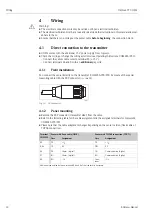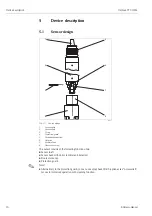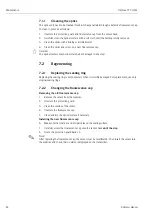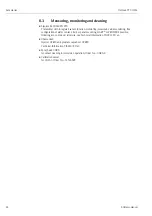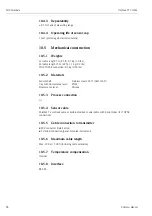
Oxymax W COS61
Device description
Hauser
17
5.2
Measuring principle
5.2.1
Oxygen measurement based on the principle of fluorescence
quenching
• Sensor design:
– Oxygen-sensitive molecules (markers) are integrated in an optically active layer (fluorescence
layer).
– The surface of the fluorescence layer is in contact with the medium.
– The sensor optics are directed at the underside of the fluorescence layer.
• There is an equilibrium between the oxygen partial pressure in the medium and that in the
fluorescence layer:
– If the sensor is immersed in the medium, the equilibrium is established very quickly.
• Measuring process:
– The sensor optics send green light pulses to the fluorescence layer.
– The markers "answer" (fluoresce) with red light pulses.
– The duration and intensity of the response signals is directly dependent on the oxygen contents
and the partial pressure.
– If the medium is free from oxygen, the response signals are long and very intense.
– Oxygen molecules "quench" the marker molecules. As a result, the response signals are shorter
and less intense.
• Measurement result:
– The sensor returns a signal that is in proportion to the oxygen concentration in the medium.
– The fluid temperature and air pressure are already calculated in the sensor.
5.2.2
Fluorescence cap
The oxygen dissolved in the medium is diffused into the fluorescence cap.
Suitable flow is not necessarily mandatory but it does improve the speed at which the measuring
system responds and ensures a more representative measured value compared to a measurement in
static medium.
The cap is only permeable for dissolved gases. Other substances dissolved in the liquid phase e.g.
ionic substances, will not penetrate through the membrane. Therefore, medium conductivity has
no impact on the measuring signal.
5.3
Calibration
Calibration is a means of adapting the transmitter to the characteristic values of the sensor.
Normally, sensor calibration is seldom necessary. It is necessary after:
• Changing the fluorescence cap
Within the framework of system monitoring and supervision, for example, the calibration can also
be cyclically monitored (at typical time intervals, depending on operating experience) or renewed.
!
Note!
Ideally, use the calibration vessel (see Accessories) for calibration.












